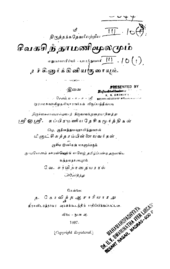Sivagasindamani
The Sivagasindamani ( Tamil : சீவகசிந்தாமணி Cīvakacintāmaṇi [ ˈsiːʋəɡəsin̪ˌd̪aːməɳi ]) is a Tamil epic . It was probably written by the Jain author Tiruttakkadevar in the 10th century . The name of the work means "Sivagan, the jewel that fulfills all wishes" (cf. Chintamani ). The Sivagasindamani is divided into 13 chapters and consists of a total of 3,145 quatrains in different variations of Viruttam -Versmaßes.
action
The Sivagasindamani tells the story of Prince Sivagan (Sanskrit Jivaka ). Before Sivagan's birth, his father, King Sachadan, is overthrown from his throne by a usurper. Before he is killed, the king manages to send his pregnant wife Visaiyai away. She then gives birth to Sivagan and entrusts him to the care of a loyal servant of the deposed king, with whom he grows up. Sivagan develops into the ideal hero and gradually marries nine women (in the Tamil tradition the Sivagasindamani is also known as Mananul , "Book of Weddings"). Finally, Sivagan challenges the usurper Kattiyankaran, defeats him in battle and is crowned king. After he got married again, he lived happily with his ten wives for many years. In the end, however, he renounces the world and becomes a Jain saint.
Dating and classification in literary history
The action of Sivagasindamani is based on Jain Sanskrit templates and ultimately goes back to the Uttarapurana written by the author Gunabhadra , which was completed in 897/898. Therefore, the Sivagasindamani cannot have been written before 900. The 10th century is considered the likely time of origin.
Together with the Silappadigaram and the Manimegalai as well as two works that are only partially preserved (the Valaiyapadi and the Kundalakesi ), the Sivagasindamani is counted among the so-called "five great epics" ( Aimperunkaviyam ) of Tamil literature. The Sivagasindamani had a great influence on the later Tamil literature, in particular on the author Kamban , who probably wrote a Tamil version of the Ramayana epic (the Kambaramayanam ) in the 12th century .
History of transmission and edition
On the Sivagasindamani there is a commentary by the author Nachinarkkiniyar from the 14th century. Like the other works of ancient Tamil literature, it was passed down for centuries in the form of palm leaf manuscripts . A first printed text edition of the first chapter, including an English translation, was published by Henry Bower in 1868 . UV Swaminatha Iyer published the first edition of the complete Sivagasindamani including the commentary by Nachinarkkiniyar in 1887 .
literature
- Text output
- Tiruttakkatēvariyaṟṟiya Cīvakacintāmaṇimūlamum Maturaiyāciriyar Pārattuvāci Nacciṉārkkiṉiyaruraiyum. Edited by UV Swaminatha Iyer. Ceṉṉai: Tirāviṭaratnākara accukkūṭam, 1887. ( first edition , numerous new editions)
- Translations
- James D. Ryan: Cīvakacintāmaṇi. The Hero Cīvakaṉ, the Gem that Fulfills all Wishes. 2 volumes. Freemont, California: Jain Publishing Company, 2005/2012.
- Secondary literature
- TE Gnanamurthy: A Critical Study of Cīvakacintāmaṇi. Coimbatore 1966.
- James D. Ryan: The Cīvakacintāmaṇi in Historical Perspective. Dissertation: University of California, Berkeley, 1985.
- R. Vijayalakshmi: A Study of Cīvakacintāmaṇi: Particularly from the Point of View of Interaction of Sanskrit Language and Literature with Tamil. Ahmedabad: LD Institute of Indology, 1981.
- Kamil Zvelebil: Lexicon of Tamil Literature . Leiden, New York, Cologne: EJ Brill, 1995, pp. 169-171.
